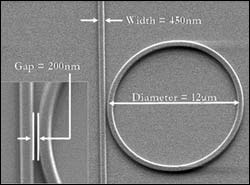Making the big step from electronics to photonics by modulating a beam of light with electricity

Cornell Nanophotonics Group - Scanning electron microscope image of the ring coupled to the waveguide with a zoom-in picture of the coupling region. Copyright © Cornell University
Much of our electronics could soon be replaced by photonics, in which beams of light flitting through microscopic channels on a silicon chip replace electrons in wires. Photonic chips would carry more data, use less power and work smoothly with fiber-optic communications systems. The trick is to get electronics and photonics to talk to each other.Now Cornell University researchers have taken a major step forward in bridging this communication gap by developing a silicon device that allows an electrical signal to modulate a beam of light on a micrometer scale.
Other electro-optical modulators have been built on silicon, but their size is on the order of millimeters, too large for practical use in integrated circuit chips. (a micrometer, or micron, is one millionth of a meter, or one thousandth of a millimeter.) Smaller modulators have been made using compound semiconductors such as gallium arsenide, but silicon is preferable for its ability to be integrated with current microelectronics.
The work is described in a paper published in the May 19, 2005, issue of Nature by Michal Lipson, Cornell assistant professor of electrical and computer engineering, and her research group.
Their modulator uses a ring resonator — a circular waveguide coupled to a straight waveguide carrying the beam of light to be modulated. Light traveling along the straight waveguide loops many times around the circle before proceeding. The diameter of the circle, an exact multiple of a particular wavelength, determines the wavelength of light permitted to pass. For the experiments reported in Nature, the ring used was 12 microns in diameter to resonate with laser light at a wavelength of 1,576 nanometers, in the near infrared.
The ring is surrounded by an outer ring of negatively doped silicon, and the region inside the ring is positively doped, making the waveguide itself the intrinsic region of a positive-intrinsic-negative (PIN) diode. When a voltage is applied across the junction, electrons and holes are injected into the waveguide, changing its refractive index and its resonant frequency so that it no longer passes light at the same wavelength. As a result, turning the voltage on switches the light beam off.
The PIN structure has been used previously to modulate light in silicon using straight waveguides. But because the change in refractive index that can be caused in silicon is quite small, a very long straight waveguide is needed. Since light travels many times around the ring resonator, the small change has a large effect, making it possible to build a very small device.
In tests, the researchers found that the device could completely interrupt the propagation of light with an applied voltage of less than 0.3 volts. The researchers note in their paper that devices using a PIN configuration have been relatively slow in switching but that the ring resonator configuration also eliminates this problem. Tests using a pulse-modulated electrical signal produced an output with a very similar waveform to the input at up to 1.5 gigabits per second.
The Nature paper is titled “Micrometer-scale Silicon Electro-Optic Modulator.” Co-authors are Cornell graduate students Qianfan Xu and Bradley Schmidt and postdoctoral researcher Sameer Pradhan, now at Intel Corp.
Media Contact
More Information:
http://www.cornell.eduAll latest news from the category: Power and Electrical Engineering
This topic covers issues related to energy generation, conversion, transportation and consumption and how the industry is addressing the challenge of energy efficiency in general.
innovations-report provides in-depth and informative reports and articles on subjects ranging from wind energy, fuel cell technology, solar energy, geothermal energy, petroleum, gas, nuclear engineering, alternative energy and energy efficiency to fusion, hydrogen and superconductor technologies.
Newest articles

ASXL1 Mutation: The Hidden Trigger Behind Blood Cancers and Inflammation
Scientists show how a mutated gene harms red and white blood cells. LA JOLLA, CA—Scientists at La Jolla Institute for Immunology (LJI) have discovered how a mutated gene kicks off…

Recharging the Future: Batteries Built for Extreme Cold Using Negative Thermal Expansion
Most solids expand as temperatures increase and shrink as they cool. Some materials do the opposite, expanding in the cold. Lithium titanium phosphate is one such substance and could provide…

Self-Destructing Cancer Cells: Cutting-Edge RNA Breakthrough
Jülich scientists use novel RNA technology to selectively switch off tumours in the brain. An Adaptable Platform Technology That Destroys Glioblastoma Cancer Cells Using a special RNA molecule, a team…



